Urban Diplomacy in Iran: Examples, Strategies, and Perspectives
Introduction to Urban Diplomacy in the Islamic Republic of Iran
Definitions, Key Concepts, and the Importance of Urban Diplomacy in the Context of Iran’s Foreign Policy and National Development
Urban diplomacy, as a modern manifestation of international interactions in the era of globalization, has increasingly drawn attention. This concept refers to “the art of employing international relations to enhance interactions, negotiations, development, and improvement of relations between citizens of cities around the world.” Its primary focus extends beyond governments to include “nations” and “citizens.” In a world where cities have become prominent actors on the transnational stage, urban diplomacy serves as a tool to achieve various goals, such as attracting tourists and investors, boosting economic growth, and facilitating the exchange of cultural identities and information. This form of diplomacy can take bilateral or multilateral forms, operating on regional and global scales.
The significance of urban diplomacy lies in its capacity to establish connections beyond formal state-to-state relations, particularly when tensions exist between governments. In such circumstances, municipalities—as direct representatives of citizens—can play an effective role in improving international relations and fostering mutual understanding. Urban diplomacy is not merely symbolic; it is a practical tool for achieving national and urban development goals, encompassing economic, social, cultural, and political aspects.
One of the key aspects of urban diplomacy is its synergy with a nation’s public diplomacy. These two domains, especially in cultural and economic engagements, can reinforce each other. This synergy helps strengthen the country’s “soft power” and counter negative international portrayals, such as the phenomenon of Iranophobia. With its emphasis on citizens and people-to-people interactions, urban diplomacy creates more stable foundations for international relations, less vulnerable to political fluctuations. Therefore, success in this arena can indirectly contribute to the broader objectives of foreign policy and enhance mutual understanding between nations—even during times of diplomatic strain.
Moreover, urban diplomacy has become increasingly intertwined with sustainable urban development, the improvement of citizens’ quality of life, and the promotion of good urban governance. The exchange of experiences in areas such as clean transportation, waste management, and the development of smart cities through inter-city collaborations are clear examples of this connection. This indicates that urban diplomacy in Iran is not merely ceremonial but is increasingly being viewed as a practical strategy for solving urban problems and achieving higher standards of living and sustainable development.
Main Actors of Urban Diplomacy in Iran: Municipalities, the Central Government, and Civil Institutions
The success of urban diplomacy depends on the collaboration and coordination of multiple actors. In Iran, the primary actors in this field include:
-
Municipalities: Especially those of major cities such as Tehran, Isfahan, Shiraz, Tabriz, and Mashhad, play a leading role in urban diplomacy. Through their international affairs departments and offices, they engage in sister city agreements, membership in international urban organizations, and joint projects.
-
The Central Government (especially the Ministry of Foreign Affairs): The central government—particularly the Ministry of Foreign Affairs—acts as a supporter, coordinator, and facilitator in urban diplomacy initiatives. Its cooperation is vital, especially in complex modern settings like the BRICS group. The country’s overall foreign policy and national interests set the framework for urban diplomacy activities.
-
Civil institutions and non-governmental organizations (NGOs): These entities, along with universities, play a key role in cultural, historical, touristic, and academic interactions, significantly contributing to the sustainability and depth of people-to-people relationships.
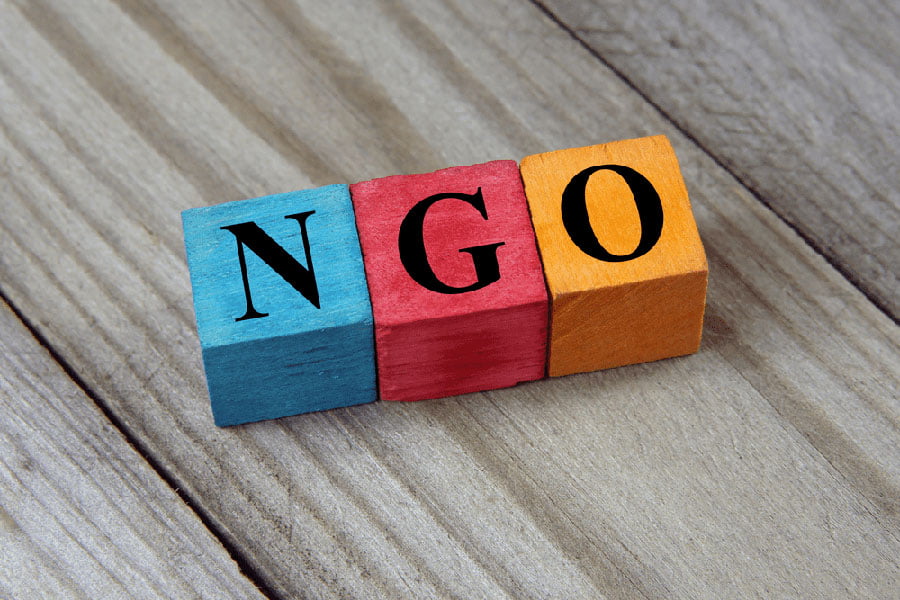
While interaction between municipalities and the central government is essential for advancing urban diplomacy, it is not without challenges. Although the central government’s support—particularly that of the Ministry of Foreign Affairs—is crucial, misalignment or differing priorities can create obstacles. Urban diplomacy inherently requires a degree of autonomy for municipalities, yet this independence must be exercised within the framework of national policies and in full coordination with the country’s diplomatic apparatus. Therefore, there is a pressing need for clear mechanisms to define responsibilities and coordination among different actors, along with further empowerment of municipalities in alignment with national interests.
Furthermore, it appears that the full potential of civil institutions and academic bodies in Iran’s urban diplomacy remains underutilized. While NGOs and universities have played prominent roles in some instances—such as the “Citizen Diplomat” project in Isfahan or academic collaborations—their capacity to add depth, sustainability, and innovation to inter-city relations far exceeds current levels. Enhancing their involvement could lead to a more specialized, citizen-centric, and ultimately more effective practice of urban diplomacy in Iran.
An Overview of the Evolution of Urban Diplomacy in Iran
Inter-city relations in Iran have deep historical roots. The Silk Road, for example, was not just a trade route but also a medium for the exchange of ideas, cultures, and innovations between cities along its path. This rich heritage can serve as both a symbolic and substantive resource for Iran’s contemporary urban diplomacy.
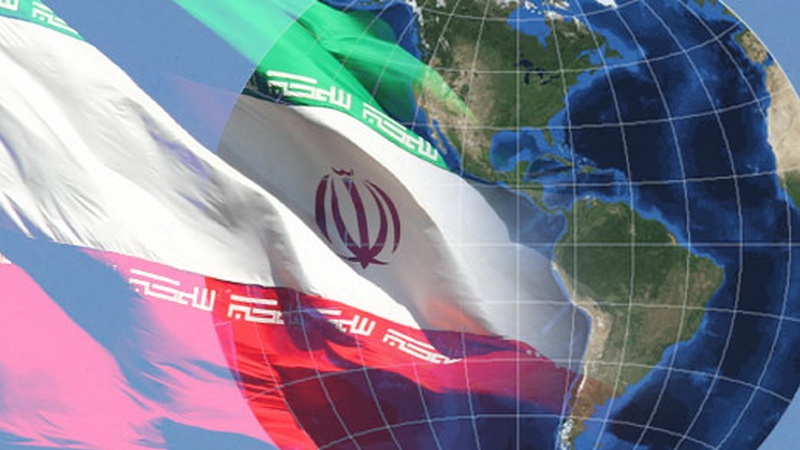
In modern times, sister city agreements have long been practiced among Iran’s major cities. For example, even before the Islamic Revolution, Tehran had established sister city relations with cities like Seoul (1963) and Los Angeles (1972). After the revolution—particularly from the 1990s onward—such activities became more structured and widespread. Tehran’s first post-revolution sister city agreement was with Bishkek, the capital of Kyrgyzstan, in 1994.
In recent years, there has been a growing emphasis on urban diplomacy and efforts to operationalize agreements to yield tangible outcomes. The creation of specialized departments such as the Office for Economic Diplomacy and the Office for Citizen Diplomacy within Tehran Municipality, and efforts to participate actively in international organizations and global events such as BRICS cities summits, reflect this maturing approach.
This evolution marks a transition from a largely symbolic diplomacy to a functional and results-oriented one. While past sister city agreements were often ceremonial, today there is increasing emphasis on implementing these agreements and achieving real economic, cultural, technical, and social outcomes. This shift reflects a growing maturity in Iran’s urban diplomacy and a desire to justify investments in the field through tangible results.
Of course, urban diplomacy in Iran has always been influenced by major domestic and international political and economic developments. Periods such as the Iran–Iraq War or economic sanctions have undoubtedly affected the scope and quality of urban diplomacy—sometimes causing stagnation, other times prompting creative alternatives for engaging with the global community. On the other hand, emerging international opportunities—such as Iran’s membership in the Shanghai Cooperation Organization and the BRICS group—offer new motivation and platforms for expanding Iran’s urban diplomacy. This requires flexibility, foresight, and the formulation of strategies suited to changing global conditions.
Notable Examples of Urban Diplomacy in Iran’s Major Cities: Case Studies
-
Tehran: As the capital of the Islamic Republic, Tehran Municipality engages in wide-ranging urban diplomacy activities. These include a broad network of sister city agreements, membership in international organizations, and various initiatives in economic, cultural, and civic fields.
-
Isfahan: With its rich historical and cultural heritage, Isfahan is one of the most active Iranian cities in the realm of urban diplomacy. Drawing on its world heritage status and innovative capacity—especially in academia—it actively seeks to expand international engagement.
-
Shiraz: Known for its literary and artistic legacy, Shiraz blends culture, art, and sustainable development in its international relations.
-
Tabriz: With a distinguished historical background and strategic geographical location in northwestern Iran, Tabriz holds significant potential for urban diplomacy, particularly with neighboring countries and culturally connected regions.
-
Mashhad: As the spiritual capital of Iran and one of the most important religious destinations in the Islamic world, Mashhad’s urban diplomacy centers around pilgrimage, Razavi culture, and the development of related services.
Urban Diplomacy Activities in Other Iranian Cities (Brief Examples)
Urban diplomacy in Iran is not limited to the major metropolitan areas. Many medium-sized and smaller cities are also active in this field, leveraging their unique capacities and characteristics. These activities reflect a growing awareness of the importance of international engagement at the local level for development and cultural exchange.
-
Qazvin: This historic city has established sister-city relationships with 12 cities. The Qazvin municipality actively seeks to expand this network. For instance, it has pursued a twinning agreement with Khujand in Tajikistan aimed at fostering cultural, tourism, and economic exchanges.
-
Neyshabur: Known as the city of Khayyam and Attar, Neyshabur is twinned with 12 cities around the world, including Khoy (Iran), Konya (Turkey), Ghazni (Afghanistan), and Kashan (Iran). These relationships are largely based on deep cultural and literary commonalities.
-
Rasht: The capital of Gilan province has sister-city agreements with nine cities, including Trabzon (Turkey), Kutaisi (Georgia), and Kazan (Russia). These collaborations can focus on areas such as tourism, agriculture, and experience-sharing in coastal city management.
-
Yazd: Famous for its unique desert architecture, Yazd is twinned with cities such as Jasberény (Hungary). Due to its shared historical and cultural heritage, particularly in adobe architecture and ancient trade routes, Yazd also has ties with Khiva in Uzbekistan.
-
Kashan: Known for its damask rose and rosewater production as well as historical architecture, Kashan is twinned with Kazanlak in Bulgaria, which is also famous for rose production. This is an example of a twinning relationship based on a specific shared product or economic advantage.
-
Other cities: The list of Iranian cities active in urban diplomacy is not limited to these examples. Cities such as Abadan, Karaj, Astara, Arak, Ardabil, Bandar Anzali, Sabzevar, Bam, and Semnan also have one or more sister-city agreements with international partners.
The involvement of this wide range of cities in urban diplomacy shows that this is no longer a phenomenon exclusive to the capital or a few large metropolises. Different cities are pursuing international connections and the benefits they bring—whether historical, cultural, economic, natural, or industrial—based on their unique capacities. This can contribute to more balanced regional development by attracting experience, technology, investment, and tourism, and can also help present a more comprehensive and favorable image of Iran on the global stage.
Common Tools and Mechanisms in Urban Diplomacy in Iran
To advance their diplomatic goals, Iranian cities utilize a set of internationally recognized tools and mechanisms. These tools enable cities to connect with foreign counterparts, identify shared interests, and collaborate to realize them.
Sister-City Agreements and Memorandums of Understanding (MoUs)
Sister-city agreements and MoUs are the most common and well-known tools in Iran’s urban diplomacy. These are formal or semi-formal agreements between two cities that aim to foster human and cultural solidarity and connect citizens of both communities through mutual interests in areas such as culture, economy, commerce, history, science, customs, or even religion.
The process of establishing these partnerships usually begins with proposals by expert delegations, followed by negotiations to define areas of cooperation, and finally the drafting and signing of an agreement or MoU.
These agreements may encompass a wide range of activities, including the exchange of urban management expertise, personnel training, tourism development, joint cultural and handicraft exhibitions, and groundwork for economic and trade cooperation. However, a key challenge lies in the effectiveness and sustainability of these partnerships. As seen in the case of Tehran, the quantity of agreements does not necessarily indicate success. Without specific operational plans, sufficient resources, and continuous follow-up mechanisms, many agreements risk becoming symbolic and forgotten. Therefore, there is a growing need for a more qualitative approach rather than simply increasing the number of agreements—one that focuses on identifying real mutual interests and feasible joint programs.
Cultural, Scientific, Economic, and Tourism Exchanges
Exchanges in cultural, scientific, economic, and tourism fields form the core and practical content of many urban diplomacy initiatives in Iran. These exchanges enable cities to benefit from each other’s capacities and foster mutual understanding among their citizens.
Examples include:
-
Cultural and artistic: Cultural delegations, reciprocal cultural weeks, handicraft and visual art exhibitions, joint music and theater performances, and the exchange of literary and cinematic works.
-
Scientific and educational: Student and faculty exchanges between partner city universities, joint research projects, academic workshops and seminars, and knowledge transfer in urban management.
-
Economic and commercial: Foreign investment attraction for urban projects, development of bilateral trade, export of technical and engineering services (e.g., metro construction, smart city systems), and opportunities for local firms to access global markets.
-
Tourism: Growth of tourism, particularly cultural, historical, religious (e.g., in Mashhad and Qom), and health tourism (e.g., in Shiraz and Mashhad), through promotion, travel facilitation, and standardized tourist services.
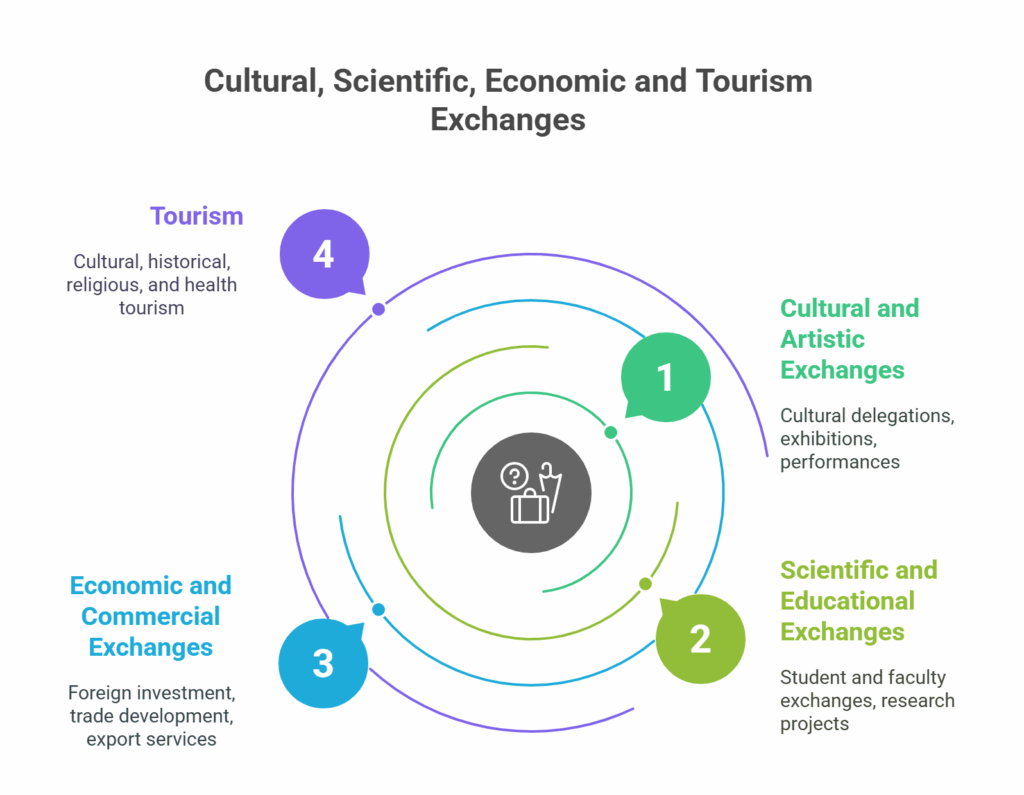
Given Iran’s rich cultural and historical heritage and its unique religious and natural attractions, tourism (in its various forms) and cultural exchange often serve as entry points and main pillars of Iran’s city-to-city collaborations. While this is a comparative advantage, sustainable economic and cultural outcomes require proper infrastructure, internationally standard services, and professional marketing.
Participation in International Organizations, Networks, and Events
Membership and active participation in international organizations, networks, and events are other important mechanisms of urban diplomacy for Iranian cities. Through such engagement, cities can stay informed of global trends in urban management, learn from best practices, present their own achievements and challenges, and collaborate on shared issues.
Major Iranian cities such as Tehran, Isfahan, Shiraz, Tabriz, and Mashhad are members of or actively participate in numerous organizations, including Metropolis (World Association of Major Metropolises), United Cities and Local Governments (UCLG) and its regional branches, the Organization of Islamic Capitals and Cities, UNESCO’s thematic networks (e.g., Learning Cities, Creative Cities), the World Smart Sustainable Cities Organization (WeGO), the Asian Mayors Forum, and more recently, the BRICS Cities Union.
In addition to organizational membership, participation in international events such as specialized urban management expos (e.g., Tehran’s “Shahriran” Expo), conferences, and summits provides opportunities for networking, learning, and showcasing capabilities. The growing importance of international networking for knowledge exchange and influence has led Iranian cities to become more active in these arenas. Such networking not only enhances internal urban management capacities but can also raise the international profile and influence of Iranian cities—and by extension, the country itself.
Public Diplomacy and City Branding
Urban diplomacy, in its broader sense, is considered a branch of public diplomacy aimed at influencing foreign public opinion and creating a positive image of a city or country. In this context, city branding serves as a strategic tool to distinguish a city, highlight its unique features, and attract investment, tourism, talent, and global attention.
However, city branding remains a significant yet challenging objective for Iranian cities, including Tehran. Building a strong and sustainable city brand is a complex, long-term process that requires a clear understanding of the city’s identity, values, and competitive advantages, the definition of coherent key messages, and creative, coordinated use of all diplomatic and communication tools. Holding isolated events or short-term campaigns is not enough to achieve effective branding.
Effective tools for city branding include the use of domestic and international media, hosting high-quality cultural, artistic, and sports events with global appeal, showcasing technological and innovative achievements, and telling human and cultural stories of the city. Without a cohesive branding strategy and adequate investment, urban diplomacy efforts may fall short of making a lasting and impactful impression on the global stage.

Challenges and Opportunities for Iran’s Urban Diplomacy
Despite significant progress and achievements, urban diplomacy in Iran faces various internal and international challenges—as well as noteworthy opportunities—that will shape its future trajectory.
Internal Barriers: Institutional Incoherence, Lack of Strategic Planning, Legal and Structural Constraints
Some of the key internal challenges include:
-
Institutional incoherence: In some cases, the roles and responsibilities of various bodies involved in public and urban diplomacy (such as the Ministry of Foreign Affairs, Ministry of Interior, Islamic Culture and Relations Organization, and municipalities) are not clearly defined. Independent or parallel activities by these bodies may lead to inefficiency and reduced impact. Poor coordination between municipalities and central government also hinders cohesive urban diplomacy aligned with national interests.
-
Lack of strategic planning: Despite numerous activities, many Iranian cities—including Tehran—suffer from the absence of effective and operational strategies for urban diplomacy. Without clear long-term goals, mid-term strategies, and actionable policies, efforts remain fragmented and often ineffective.
-
Legal and structural limitations: The absence of specific laws and regulations to support and facilitate international activities by local governments and municipalities—and to allow for involvement by NGOs and the private sector—poses another obstacle. Broadly speaking, weaknesses in the country’s public diplomacy structure impact urban diplomacy as well.
-
Resource constraints: Limited and unstable financial resources, along with a shortage of trained and specialized personnel in international relations and law within municipalities, present serious barriers.
-
Low participation and underused capacities: In some cases, municipal participation in international organizations and events is insufficient and lacks impact. Furthermore, the vast potential of the Iranian diaspora and Iranian experts working in international urban organizations is underutilized.
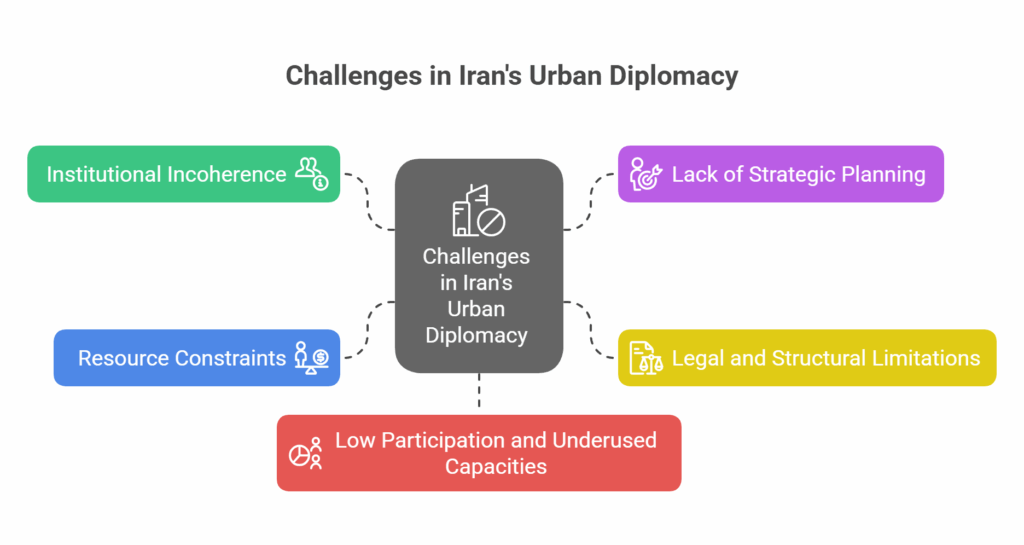
These internal issues show that the effectiveness of Iran’s urban diplomacy heavily depends on structural and institutional reforms at both national and local levels. Without resolving these barriers, even favorable international opportunities may not be fully capitalized on. Developing a national strategic document on urban diplomacy—with input from all stakeholders—could be a crucial step toward overcoming these challenges.
International Challenges: Sanctions, International Image, and Regional Competition
Urban diplomacy in Iran also faces challenges in the international arena:
-
International sanctions: Economic and financial sanctions imposed on Iran undoubtedly affect urban diplomacy activities. They can hinder financial transactions, technology transfer, foreign investment attraction, and even municipal representatives’ participation in certain international events and organizations. The continuation of sanctions impacts the overall landscape of Iran’s international engagement.
-
Global image: Widespread negative portrayals in some Western and international media pose a serious challenge to Iran’s public and urban diplomacy. Such portrayals may discourage other countries and cities from establishing relations with Iranian counterparts. Combating Iranophobia and promoting a realistic, positive image of Iran are essential prerequisites for progress in this area.
-
Regional competition: Major cities in the Middle East and West Asia are increasingly expanding their urban diplomacy activities. This intensifies competition over attracting investment, tourism, hosting international events, and gaining influence in global urban networks.
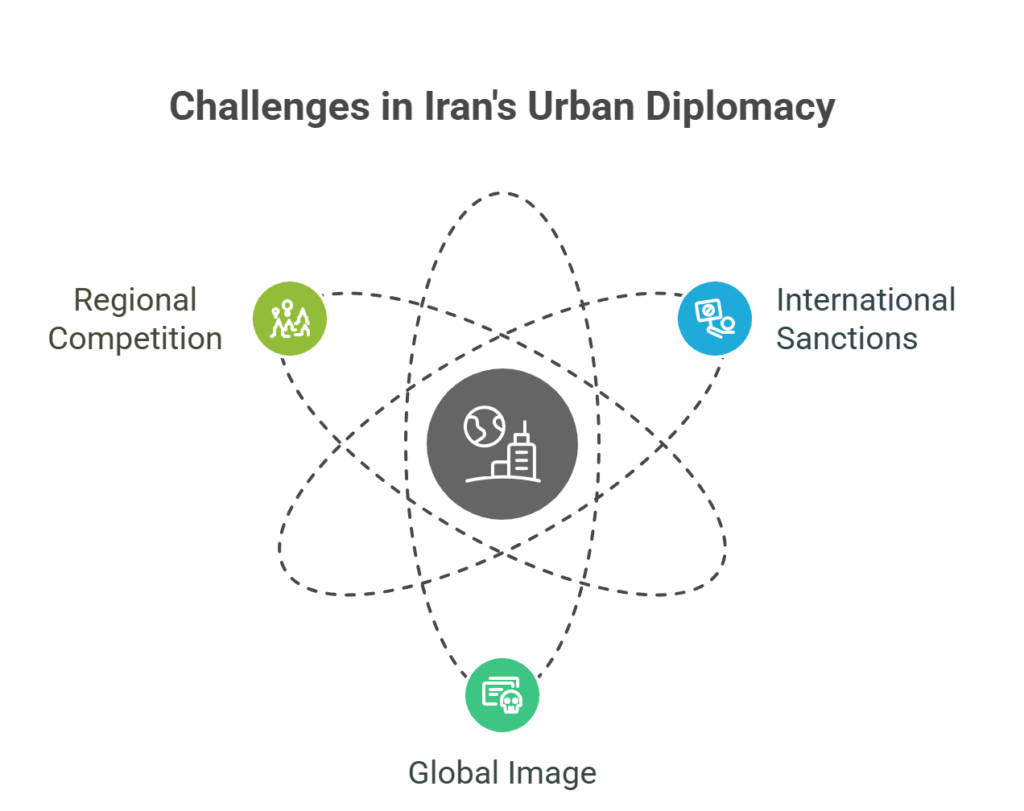
Nonetheless, urban diplomacy can also serve as a tool for mitigating the negative effects of these international challenges. In a context of sanctions and image issues, urban diplomacy can focus on non-political and human-centered domains such as culture, arts, sports, the environment, and urban management exchange. This “track-two diplomacy” can create alternative and effective communication channels with the outside world. It can gradually improve Iran’s image, foster mutual understanding, and lay the groundwork for broader cooperation in the future. As such, smart and targeted investment in urban diplomacy can form part of a national strategy to counter international isolation and pressures.
Opportunities: Rich Cultural and Historical Heritage, Economic and Scientific Capacities, Membership in New Alliances (e.g., BRICS)
Despite the challenges, Iran’s urban diplomacy has considerable opportunities that can help it grow and thrive:
-
Rich cultural and historical heritage: With its ancient civilization and exceptional cultural and historical legacy, Iran holds a tremendous asset for urban diplomacy. Cities like Isfahan, Shiraz, Yazd, Tabriz, and Hamedan each represent a treasure trove of history, art, architecture, and literature that can strongly appeal to tourists, scholars, and artists worldwide. This heritage can serve as the foundation for many cultural collaborations and inter-city exchanges.
-
Economic and scientific capacities: Especially in some metropolises, Iran possesses notable economic, industrial. scientific capacities that can serve as foundations for urban diplomacy. Cities such as Tehran, Isfahan, Tabriz, and Mashhad host major universities, research centers, and industrial hubs that can promote international cooperation in areas such as smart city technologies, urban planning, renewable energy, transportation systems, and medical tourism. These assets can be used to attract international partners for joint projects and knowledge sharing
Membership in new international alliances (e.g., BRICS): Iran’s recent accession to the BRICS group provides a new geopolitical and economic framework that can also impact urban diplomacy. Iranian cities may benefit from forming sister-city relationships and urban cooperation networks with cities in BRICS countries. These partnerships can help Iranian cities bypass some of the challenges related to sanctions or regional competition by shifting towards South–South cooperation and alternative international platforms.
Conclusion
Urban diplomacy in Iran is evolving beyond a symbolic or ceremonial activity, becoming a strategic tool for international engagement, development, and cultural exchange at the local level. While challenges—both domestic and international—persist, the growing awareness of the value of city-to-city cooperation, along with Iran’s rich cultural heritage and urban diversity, provides a strong foundation for further development.
To realize the full potential of urban diplomacy, a more strategic, coordinated, and well-resourced approach is essential. This includes creating national frameworks to support local governments, enhancing inter-agency coordination, investing in human resources and international expertise within municipalities, and leveraging diaspora networks and digital tools for global outreach.
Ultimately, effective urban diplomacy can contribute not only to the balanced development of different regions of Iran, but also to improving the country’s image on the global stage—through people-to-people ties, shared cultural values, and cooperative solutions to common urban challenges.

